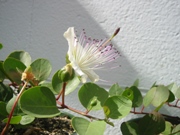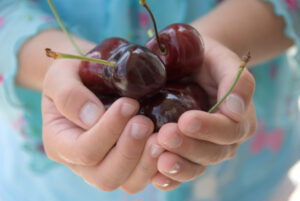
The great Caper caper
Virgil Evetts
This isn’t going to be one of my usual wide swaths of cynicism columns, nor will it be a list of hot and not. This week, I’m dedicating my lines to just one topic (with a few deviations along the way); those mysterious little punctuations of taste called capers. You know them and you may love them or hate them, but in my experience there aint no in-between. Furthermore, no matter how you feel about capers, I’d just about guarantee that you don’t know much about them. Almost nobody does. Because unlike olives, anchovies and all those other strangely allied anti pasto antagonists, capers are an ingredient easily overlooked and often taken for granted. It’s hardly surprising really; they are small, ruddy and tragically inconspicuous. If applied carelessly to a dish they are either lost under dense layers of flavour or they jump out at you, starkly sharp and salty. But when you take the time to really understand capers, and to use them with a little care and respect they can become a true love, or in my case, an obsession.
I’m a person of obsessions, I suppose. Always have been. They wax and they wane like the moon and the tides. I’d always been fond of capers but true obsession didn’t really get started until I got hold of some seeds in Italy (all perfectly legal, before you ask), which led to my first baby caper plants, which led to my first (admittedly meagre) home caper harvest. The experience proved that capers would grow quite happily in New Zealand, which was no small discovery. My frankly exhaustive research (as is the way of obsessive types) indicated that nobody had ever tried to grow capers here before, let alone succeeded.
So obsession took hold and I could think of nothing else. It was all very parp-parp, Mr Toad-esque. I began to entertain all sorts of lofty dreams. I’d start a new life as a caper farmer – in the Hawkes Bay perhaps. Maybe I’d write waffly, costmeticised books about the good life and become the next Peter Mayle…
Fortunately reason (via the dulcet, yet ever practical tones of my Best Beloved)-prevailed; horticulture is horrible, back-breaking work. The labour costs are crippling, the returns miniscule and in the case of capers you are competing against growers in some of the poorest nations on Earth, who will cheerfully undercut you by a small fortune per kilo. She also reminded me that I hate Peter Mayle and that whole genre of Tuscan Sun/Year in Provence, toffee-nosed tossers in the wop-wops. I would just have to make do with my backyard smallholding. For now.
The Caper, or Capparis spinosa is a straggly, low-growing deciduous plant native to the Mediterranean basin. The part we call a caper is the juvenile (the smaller the better) flower bud. If allowed to fully mature these buds give way to exquisite, white petalled blooms with long purple stamens. They have a delicious, albeit surprising fragrance- they smell almost exactly like those old fashioned pink smoker sweets (why are these called smokers?). These lovely flowers eventually go on to form a fruit, the caper berry, which in recent years had become something of deli standard. Waste of a good caper bud if you ask me. I’m with the Italians and French who traditionally regard caper berries as inferior muck suitable only for tourists. Well maybe that’s bit harsh, but considering the horror of my one and only oral encounter with a freshly picked caper berry, I think it’s quite justified. Without wanting to bore you with details I can report that fresh caper berries have the texture of gritty mucous and taste like vomit. Exactly like vomit. Even though the pickling process removes all trace of this unpleasantness, I still can’t look at a caper berry without the bile creeping up my throat.
Rather like olives, unless you are possessed of extremely masochistic inclinations, capers are almost inedible in their natural state. They contain a mouth-puckeringly bitter substance called glucocapparin which is only broken down into a palatable form during the pickling or salting process, leaving the buds with a mellow, almost mustardy flavour and a slight spiciness. Glucocapparin is also found in nasturtiums (an unrelated species), the seeds of which are sometimes pickled as mock capers. While it’s true that these taste rather a lot like capers, the illusion is somewhat ruined by their strange, cartilaginous texture. Stick with the real deal unless you’re into caper flavoured gristle.
If you’ve visited Italy, Spain or any other stretch of the Mediterranean coast line, you may have seen hundreds of capers bushes without realising it. Capers are one of the more common weeds around the Med and are often seen clinging to ancient ruins, sometimes many meters up old towers and columns. All the great, picture-post card archaeological sites of Italy, the Coliseum, Pompeii, Herculaneum and so on are veritable caper plantations.
Until a few a decades ago all capers were wild harvested, but these days demand far outstrips supply. The majority of capers are now commercially cultivated, with Spain and Morocco producing the lion’s share. In recent years a boutique caper industry has sprung up in South Australia, so maybe there’s hope for my caper farm yet. Harvesting capers however, is no job for soft city hands or clapped -out townie backs. The plants are often viciously thorned [the thorny characteristic is carried on a recessive gene] and grow very low to the ground, meaning shredded fingers and hours of painful bending. The job of the wild caper picker is even more perilous, often requiring the scaling of crumbling cliffs and hillsides in baking summer heat. This goes some way towards explaining why wild capers are so heinously expensive.
All parts of the caper plant are edible- those perfect little buds, the large, crunchy berries, (you know how I feel about those), even the crisp, succulent leaves. The latter were the exclusive perk of the caper harvester in years gone-by, (the main crop being far too valuable for home consumption). After the usual treatment of salting or pickling these make a very good caper substitute, certainly better than that nasty nasturtium carry-on.
Despite the general foodie stance on the matter, I’m no great fan of salted capers; yes they do have a truer caper flavour than pickled, but who can be bothered with all that soaking and rinsing? Time better spent behind a wine glass methinks.
So what to do with capers? The golden rule is don’t get too clever. Capers have a delicate flavour and deserve to shine through.
Caper mayonnaise
Finely chop 2 tablespoons of capers and fold through fresh mayo with just a twist of white pepper. This goes particularly well on a poached chicken salad- cos lettuce, a little onion, cherry tomatoes, fried croutons and poached, free-range bird. A perfect autumn lunch.
Salsa verde
An Italian standard and an exemplar of the strange chemistry that exists between anchovies and capers. This sauce is equally good with sizzling, fatty meats, raw vegetables or just mopped up with bread. Blend or pound together lots of capers and lots of parsley with garlic, anchovies and olive oil. Season to taste. Don’t ask for proportions ‘cos I shan’t tell. Use the force.
Caper and anchovy stuffing
Even if you’re not an anchovy sort of person, you’ll like this one. Promise. To a cup of bread crumbs add 1 fried onion [finely chopped], 4 chopped anchovy fillets, 2 tablespoons+ capers, ¼ cup chopped pistachio nuts. Mix together with a little water and olive oil, season to taste. This stuffing works particularly well with red meats.
Smoked fish mornay
Make a thick béchamel with lots of sharp, aged cheddar, a little white wine and plenty of capers. Fold in as much succulent smoked kahawai as you can afford. Season to taste and spoon into heavy, individual, oven-proof bowls (preferably of the uber-retro earthenware kind). Top with more cheese, bread crumbs and bake until golden brown and angrily sizzling. Serve white-hot with plenty of crusty bread and gallons of wine.
Sizzling antipasto
Into a pan of spitting-hot olive oil drop a handful of capers, pitted Kalamata olives and de-seeded chillies. Quickly stir-fry until lightly browned and crispy. A punchy little partner to cured meats on a lavish anti-pasto platter.




Hmm
Ive only had the big, fully developed seeds pickled. They tasted as described above.Maybe I’ll try again with smaller ones.
Thanks
Virgil
Virgil, I pickled the seed pods and you know how they grow in a tiny bunches of say 3 – well, I just break them up so that they’re all separated. I must say, I don’t really know why you’d bother picking the flowers. I usually make up approx 3 small jars at a time and when I gave a jar away to a friend, my partner wasn’t too happy!
I love capers – as Lorna said a great combination with salmon – the sharpness cuts through the richness.
My most common way to use them is in Puttanesca Sauce, the anchovies, chilli, olives and capers create a sensational taste, this is my most favourite “store cupboard, need to go shopping but not today” meal.
I usually buy them brined but have bought salted and to be honest could not really tell the difference. With olives I am a little bit picky as to the types of olives and the country of origin etc.. not so with capers. And I did buy caperberries to have on a platter with a great pate but was not sold on them and they languished in the fridge for a very long time.
Like Tessa, I like pickled nasturtium buds.Actually I like them a lot. Not gritty at all.
I put them in all. my daughter-in-law’s Christmas hampers on request every year
Tessa did you pickle the flowers or the seeds? Ive been keen to try the flowers out despite my issues with the seeds!
Skate wings! I havnt had those for years- they’re just lovely and I’ll def try with black butter and capers.
Salmon and capers are perfect together too- specially with a little dill.
Your article was sooo interesting. I’ve often wondered about capers and how to grow the plant etc. I have nasturtiums and I did pickle some ‘poor man’s capers’ in January and sorry Virgil, but they’re actually rather nice. Certainly not real capers of course but it was an interesting experiment and they don’t taste grisly at all. In fact, they taste like you’re eating capers but that they have a slight nasturtium taste which is quite a change. To Lorna – you should try yours as I was a bit scared to as well, but was pleasantly surprised. Anyway, very interesting as I just love capers.
Yes, me too. I always have a large jar in the fridge. I put a large spoonful in the black butter I drizzle on skate wings. And other things.
Smokers – so named, I think, because they masked smoker’s ashtray breath.
I’m a caper-lover, especially in various last-minute sauces that accompany fresh salmon. My favourite is the simplest. Fry a salmon fillet in butter till the skin is crisp and the fish just cooked (the butter will blacken, but this is OK). Add a further knob of butter to the pan and when melted add 5 or 6 chopped capers, a squeeze of lemon juice and some fresh parsley. Sizzle for a matter of seconds only till hot. Drizzle over the salmon fillet.
Virgil, I once pickled some nasturtium seeds but couldn’t bring myself to put one in my mouth after the 6 week pickling period. I wasn’t game enough – just in case the process hadn’t worked and there might have been some deadly bug in there, even though I followed the standard pickling process. Illogical, I know, but such is life.